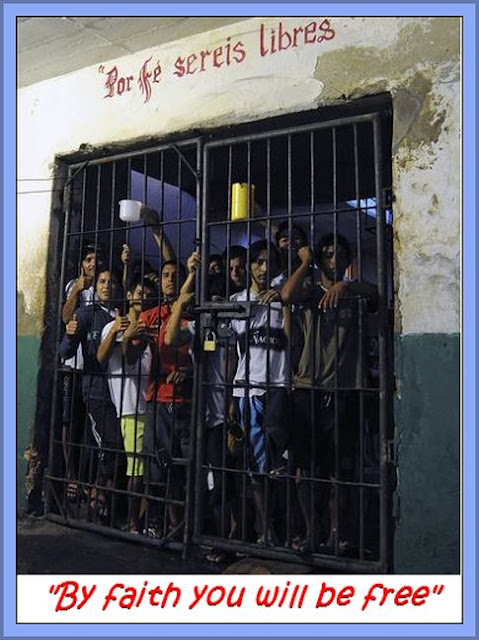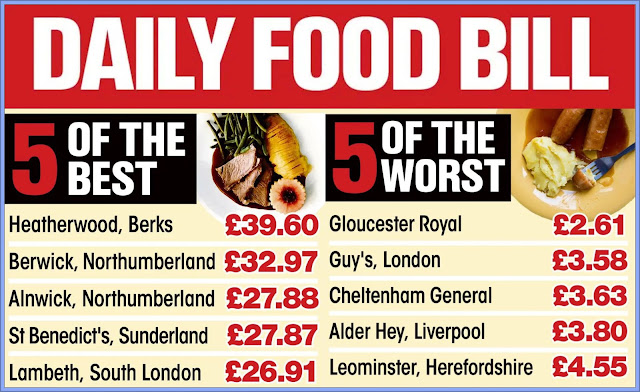I was watching one of those 'Worlds Toughest ...' type programs on TV a while ago ...
 |
| By Faith You Will Be Free |
... and it featured some prison in South America (possibly Tacumbú prison), where the prisoners had to rely on families or friends bringing in food, or they would probably simply starve to death, such was the poor amount of food provided by the state.
I can't recall if they got just one soup meal, or even nothing at all (although I suspect it was one vegetable broth type meal), but it was clear that you would starve to death if that was your only meal.
But for this post, the nearest to the feed yourself concept that I could find reference to, is the infamous San Pedro prison in La Paz, Bolivia, where state provided prison food is nominally minimal at best, and non existent in reality. The canteen and restaurants are owned and run by the inmates, while other places sell ingredients for those with kitchens to cook for themselves. The food has to be paid for, as indeed does the prison cells of the inmates, who have to work to pay rent for them.
However, what popped into my mind, wasn't how tough prisons are in some parts of the world, but rather, what the state spent on food in prisons, as opposed to hospital food (which in many countries was also nothing). However for first world countries this question was prompted, as I was fresh out of hospital myself, where unfortunately I had found the food to be often unappetising and even inedible, so I had an interest in the subject.
Now, lets be honest, the subject of prison food is never going be one that rouses much public interest, as long as they don't starve, the aim in most states is to keep the public costs as low as possible.
So in the UK prisons, the average daily food allowance per prisoner is £1.87 ($2.58) - although some figures state that the average is now £2.02 ($2.78) - and can be as low as £1.20 ($1.65). In the US, the individual states are responsible for local jail food, but the federal system is national. However, nearly all prison food in the US is now provided by private firms, and so meal planning is often by what is available at the lowest price.
So in the US, in 2013 figures, a private firm was given $2.65 (£1.92) per prisoner, per day, to feed them and make a profit (which they do). The US prison system also resorts to a product known as 'Nutraloaf' as a form of food punishment ... this is a very cheap meal. Similarly, the UK staple meal was 'porridge' for at least two meals per day, although that changed in the 20th century.
However for hospitals it depends on how the health care is paid for. In
the US for example, you might think that patients who are paying for
everything to do with their treatment, are going to expect good food
choices and standards. Whilst in a largely public expense system such as
the UK's National Health System (NHS), the costs of the food provided
are borne by the state, and therefore the aim is to keep those costs as
low as possible, but not as poor as prison food.
For UK hospitals, well it depends on who is telling you ... in 2012 the health department stated that per day the average food costs were £8.77 ($12.09) and that food costs represented just less than 0.5 per cent of the annual NHS budget.
 |
| The Daily Amount Hospitals Spend On Food Varies Greatly In The UK. |
However in 2018 it was widely reported that some hospitals were spending just £3.00 ($4.14) a day on patients meals ... an amount that was little more than the daily spend on inmate meals at the UK's prisons. Worse than this was that it was all a bit of a lottery, with some hospitals spending spending 15 times as much as others.
The US hospital food figures are not easy to find, as overcharging and inflated bills make the true figures a hidden fact. But I was able to find a vending food industry report that mentioned that hospital food costs were about $6.09 (£4.42) per patient each day in the US when the report was published .... hardly the chef silver service you might expect, in a country where health costs are so exorbitant. The report recommended that to optimise the hospitals bottom line, it should (amongst other things), bring the cost of meals per patient day to around $3 (£2.18) or less!!
In other words, the trend suggests that hospital food, whether in a public or privately funded health system, is, albeit slowly, getting closer to the standards of prison food. Of course it could be argued that bad hospital food could just encourage people not to linger in hospital any longer than needed .... but all in all, this apparent trend, if correct, makes me think that my suspicions of a few years ago are being confirmed.

No comments:
Post a Comment
All comments are welcomed, or even just thanks if you enjoyed the post. But please make any comment relevant to the post it appears under. Off topic comments will be blocked or removed.
Moderation is on for older posts to stop spamming and comments that are off topic or inappropriate from being posted .... comments are reviewed within 48 hours. I don't block normal comments that are on topic and not inappropriate. Vexatious comments that may cause upset to other commentators, or that are attempting to espouse a particular wider political view, are reviewed before acceptance. But a certain amount of debate around a post topic is accepted, as long as it remains generally on topic and is not an attempt to become sounding board for some other cause.
Final decision on all comments is held by the blog author and is final.
Comments are always monitored for bad or abusive language, and or illegal statements i.e. overtly racist or sexist content. Spam is not tolerated and is removed.
Commentaires ne sont surveillés que pour le mauvais ou abusif langue ou déclarations illégales ie contenu ouvertement raciste ou sexiste. Spam ne est pas toléré et est éliminé.